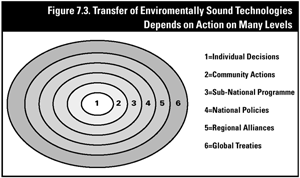|
7.7 Role of Community Groups in Technology Transfer5
Within Countries
Technology transfer strategies are recognising alternatives to the old paradigm
that envisioned all change as being mandated by top-down directives. The pervasive
influence of community programmes has been recognised; these programmes often
involve a vibrant mix of stakeholders, representing international, national,
regional, city and community organisations (See Figure
7.3). With increasing frequency, programme responsibilities are being delegated
by national governments to regional and local governments and community organisations.
In Russia, for example, the 89 regional governments are moving toward a federal
structure with a more flexible fiscal system that is more responsive to the
country's changing needs (Wallich, 1994). In Columbia, municipalities are developing
the capacity needed to take control of responsibilities formerly belonging to
the national government (World Bank, 1995). The city of Curitba has
 |
| Figure 7.3: Transfer of Enviromentally Sound Technologies Depends on
Action on Many Levels |
earned the nickname, "Ecology Capital of Brazil", through its innovative
public transportation system, garbage recycling programme, and large number
of trees, parks and green spaces (Dobbs, 1995; Fiszbein, 1999).
Within this context, there is an increased recognition of the role of communities
where citizens' organisations, such as villages, neighbourhoods, and grassroots
organisations, are the initiators in defining the need for new technologies
through a high degree of collective decision-making (See Chapter
1). The development of the Jiko cookstove, mentioned above, is an example
of a community-driven pathway (Case Study 1, Chapter
16). Many other examples are reported in a growing Best Practices Database
maintained by the Together Foundation, an NGO, and the United Nations Centre
for Human Settlements (UNCHS)-Habitat (Together Foundation, 1999).
Some of these examples:
- In Benavides, a small Argentine village north of Buenos Aires, a non-profit
civic association created a 173-home neighbourhood at 40 per cent of the cost
of private real estate developers;
- In El-Tadamon Village in upper Egypt, the inhabitants of two villages destroyed
by floods-one Moslem and one Christian-were relocated into a new village on
higher ground. The new inhabitants worked together to build 102 houses, using
a new "healthy house" design, and a textile and handcraft;
- In Rajasthan, India, the Academy for a Better World, by the Brahman Kumaris,
constructed a new village for 800 people on barren land. The complex is using
renewable energy and recycling its water to reforest the adjoining land.
An analysis by the Inter-American Development Bank of the role that community
organisations have played in alleviating poverty throughout Latin American suggests
that governments could recognise the potential of such organisations (Navarro,
1994). The objective of most community-driven initiatives has been to alleviate
poverty, which often includes improved housing. However, community leaders have
also shown a sensitivity to environmental issues (Tietenberg and Wheeler, 1998).
The community-driven pathway appears open to playing a larger role in the diffusion
of ESTs.
Among Countries
Government-to-government programmes can empower community-driven technology
transfer in two ways. The first is by simply informing communities about what
other communities have done and how they did it. NGOs, such as the Together
Foundation, can provide this information exchange, as it does through its Best
Practices Database. Through their support for the Together Foundation, the UNCHS-Habitat
and the European Union make this information exchange possible (Together Foundation,
1999). Other international NGOs also are recognizsing the potential of the community-driven
pathway, such as the International Institute for Energy Conservation, Alliance
to Save Energy, Natural Resources Defense Council, Environmental Defense Fund,
and Habitat for Humanity.
The second way to empower these community-based initiatives is to recognise
their potential role in the design of international programmes. The multinational
development banks and multilateral assistance agencies are starting to do this
in many of their analyses (Bamberger and Aziz, 1993; World Bank, 1994, 1995;
Fiszbein, 1999; Navarro, 1994). The challenge now is to work with developing
and transitioning countries to incorporate these insights into their lending
and technology assistance programmes.
|